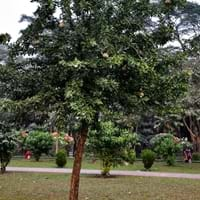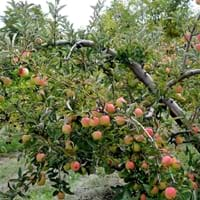Life Span
Perennial
Perennial
Origin
Bangladesh, India, Pakistan, Sri Lanka, Tropical Indomalaya
Eastern Europe, Southern Europe, Russia/Siberia, Southern Asia, Western Asia
Types
Not Available
fuji, jonathan apple
Habitat
Dry areas
Cold Regions, gardens
USDA Hardiness Zone
Not Available
3-8
AHS Heat Zone
Not Available
8-1
Sunset Zone
Not Available
1a, 1b, 2a, 2b, 3a, 3b, 6, 7, 14, 15, 16
Habit
Not Available
Oval or Rounded
Flower Color
White
White, Pink
Flower Color Modifier
Not Available
Bicolor
Fruit Color
Greyish Brown, Light Green, Not Available
Red, Yellow green
Leaf Color in Spring
Green
Green
Leaf Color in Summer
Dark Green
Green
Leaf Color in Fall
Green
Green, Light Yellow, Brown
Leaf Color in Winter
Gray Green
Light Green
Leaf Shape
Ovate
Oval Cordate
Plant Season
Autumn
Spring, Fall
Sunlight
Full Sun, Partial Sun
Full Sun, Partial Sun, Partial shade
Growth Rate
Medium
Medium
Type of Soil
Rich
Clay, Loam, Sand
The pH of Soil
Acidic, Neutral
Acidic, Neutral
Soil Drainage
Well drained
Well drained
Bloom Time
Late Fall
Early Spring, Spring
Tolerances
Drought
Drought
Where to Plant?
Ground, Pot
Ground
How to Plant?
Budding, Layering, root cutting, Seedlings
Grafting, Seedlings, Stem Planting
Plant Maintenance
Low
Medium
Watering Requirements
Do not water excessively
Do not water frequently
In Summer
Lots of watering
Lots of watering
In Spring
Moderate
Moderate
In Winter
Average Water
Average Water
Soil pH
Acidic, Neutral
Acidic, Neutral
Soil Type
Rich
Clay, Loam, Sand
Soil Drainage Capacity
Well drained
Well drained
Sun Exposure
Full Sun, Partial Sun
Full Sun, Partial Sun, Partial shade
Pruning
Prune after harvesting, Remove dead or diseased plant parts
Prune central stem, Remove lateral branches
Fertilizers
for fruiting plants, use high phosphorous content fertilizer
Apply 10-10-10 amount, fertilize in growing season, Fertilize the soil before planting
Pests and Diseases
Not Available
Bacterial Blight, Bacterial Canker, Leaf rust, Red blotch, Ring Rot, Woodpecker feeding
Plant Tolerance
Drought
Drought
Flower Petal Number
Single
Single
Foliage Texture
Medium
Medium
Foliage Sheen
Matte
Matte
Attracts
Not Available
Bees, Butterflies, Hummingbirds, Insects
Allergy
Gastric
Peripheral Edema, Vomiting
Aesthetic Uses
Not Used For Aesthetic Purpose
Cottage Garden, Showy Purposes
Beauty Benefits
Good Cleanser
Acne, For treating wrinkles, Improve skin tone, Moisturizing, Stops hair loss
Environmental Uses
Not Available
Food for animals, Shadow Tree, soil stabilisation, Windbreak
Medicinal Uses
Blood cleanser, Diabetes, Ear ache, Energy, Kidney problems, Liver Protection, Malaria, Respiratory Disorders, scurvy, Snakebite
Acne, Alzheimer’s Disease, Anemia, constipation, Gastrointestinal disorders, Hair Loss, Parkinson
Part of Plant Used
Fruits
Fruits
Other Uses
Used As Food, Used for its medicinal properties
Acts as a natural source of rain water for birds and insects., Cosmetics, Used As Food
Used As Indoor Plant
No
No
Used As Outdoor Plant
Yes
Yes
Garden Design
Edible, Fruit Tree
Edible, Fruit / Fruit Tree
Botanical Name
Limonia acidissima
MALUS domestica 'Northern Spy'
Common Name
Wood apple, monkey fruit, curd fruit
Apple, Cider Apple, Cooking Apple, Eating Apple, Northern Spy Apple
In Hindi
कबिट
Northern Spy Apple
In German
Indischer Holzapfel
Northern Spy Apfel
In French
Kawista
Northern Spy Pomme
In Spanish
Kawista
Espía del Norte de Apple
In Greek
γλυκό ασβέστη
Βόρεια κατάσκοπος της Apple
In Portuguese
Limonia
Northern Spy a Apple
In Polish
Feronia słoniowa
Northern Spy Jabłko
In Latin
dulcis ad cinerem
Northern Spy Apple
Phylum
Magnoliophyta
Magnoliophyta
Class
Magnoliopsida
Magnoliopsida
Clade
Angiosperms, Eudicots
Dicotyledonous, Rosids
Tribe
Citreae
Not Available
Subfamily
Aurantioideae
Not Available
Number of Species
Not Available
Season and Care of Wood Apple and Northern Spy Apple
Season and care of Wood Apple and Northern Spy Apple is important to know. While considering everything about Wood Apple and Northern Spy Apple Care, growing season is an essential factor. Wood Apple season is Autumn and Northern Spy Apple season is Autumn. The type of soil for Wood Apple is Rich and for Northern Spy Apple is Clay, Loam, Sand while the PH of soil for Wood Apple is Acidic, Neutral and for Northern Spy Apple is Acidic, Neutral.
Wood Apple and Northern Spy Apple Physical Information
Wood Apple and Northern Spy Apple physical information is very important for comparison. Wood Apple height is 800.00 cm and width 900.00 cm whereas Northern Spy Apple height is 370.00 cm and width 370.00 cm. The color specification of Wood Apple and Northern Spy Apple are as follows:
Wood Apple flower color: White
Wood Apple leaf color: Green
Northern Spy Apple flower color: White and Pink
- Northern Spy Apple leaf color: Green
Care of Wood Apple and Northern Spy Apple
Care of Wood Apple and Northern Spy Apple include pruning, fertilizers, watering etc. Wood Apple pruning is done Prune after harvesting and Remove dead or diseased plant parts and Northern Spy Apple pruning is done Prune central stem and Remove lateral branches. In summer Wood Apple needs Lots of watering and in winter, it needs Average Water. Whereas, in summer Northern Spy Apple needs Lots of watering and in winter, it needs Average Water.





